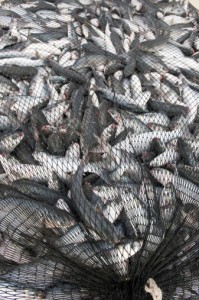The Power of Networks (Part 7)
By Asher Crispe: February 19, 2013: Category Inspirations, Networks of Meaning
 When Tikunei Ha’Zohar (43b) paints a picture of Torah scholars as fish in the Talmudic sea, it conveys a sense of the optimal learner having an unrestricted movement within fluid surroundings. Additionally, each sage is in what would today be called a fully immersive environment. Beyond this, another feature of this description is that it is an integral system in that there is a unity of the ‘water-as-Torah’ and the fish who live off the water (and who cannot live apart from it). These fish are made from and of the water–that is, the Torah scholars might be regarded as co-extensive with the Torah they teach and learn and consequently embody zones of intensity or concentrations of consciousness within the flux of the repository of all Torah wisdom. Going after one fish at a time is not necessarily the best way to achieve quality or quantity and trying to pinpoint a particular fish for capture is going to be exceedingly difficult. We can only cast our line and hope that something catches. Similarly, trying to reel in one idea at a time, to differentiate one thought from another, is a tricky business. Ideas and concepts, lessons and teachings, tend to be attached to schools of thought.
When Tikunei Ha’Zohar (43b) paints a picture of Torah scholars as fish in the Talmudic sea, it conveys a sense of the optimal learner having an unrestricted movement within fluid surroundings. Additionally, each sage is in what would today be called a fully immersive environment. Beyond this, another feature of this description is that it is an integral system in that there is a unity of the ‘water-as-Torah’ and the fish who live off the water (and who cannot live apart from it). These fish are made from and of the water–that is, the Torah scholars might be regarded as co-extensive with the Torah they teach and learn and consequently embody zones of intensity or concentrations of consciousness within the flux of the repository of all Torah wisdom. Going after one fish at a time is not necessarily the best way to achieve quality or quantity and trying to pinpoint a particular fish for capture is going to be exceedingly difficult. We can only cast our line and hope that something catches. Similarly, trying to reel in one idea at a time, to differentiate one thought from another, is a tricky business. Ideas and concepts, lessons and teachings, tend to be attached to schools of thought.
If we want to have a real sense of the sea of Talmudic knowledge, we have to try to haul in as many fish as possible. One scholar at a time won’t suffice because they are all in dialogue with one another. The way to solve this problem is to fish with a net (reshet). Here is where Tikunei Ha’Zohar (43b) highlights an important play on words by stating that it is “necessary to cast a net (reshet [רשת]) [in order to snare them] so that they will be in our possession (reshut [רשות]). The word reshut which shares the same root as reshet (net or network) can also mean ‘power’ or ‘control.’ The networks effect is to provide distributed power and control rather than centralizing it all in one place. Commentaries on this passage explain that the ‘power of networks’ (reshet–reshut) is related to the sefirah (channel or dimension of Divinity) of malchut which literally translates as ‘kingdom.’ It follows then that the concept of ‘kingdom’ relates to power and control. Specifically, the kabbalists maintain that the network referenced here is only the bottom half of the malchut (kingdom) which descends from the world of Emanation or world of unity to become manifest in the lower worlds of Creation, Formation and Action, which are also known as the worlds of separation (while the top half remains ‘submerged’ in the world of Emanation).
To elaborate on this further, we must first be reminded that the world of Emanation is a framework wherein we are exclusively conscious of Divinity. The sea of the Talmud represents the pure intuition (chochmah) that presents life as a whole and where everything we perceive is interrelated. The true Torah scholar resides in such a space of uniform connectivity and inseparability. For the outsider–the person standing on dry land, which itself denotes the lower worlds of separation–the challenge is to pick apart and solidify that by it’s nature a ‘super-fluid.’ Each of the three lower words corresponds to a garment in the soul (thought, speech, and action). These garments act like filters or nettings which allow the water to pass through them while capturing the fish. In other words, from the standpoint of the lower worlds there is no acquisition of the Torah in and of itself in its super-fluid modality (only transcendental intuition–the chochmah or ‘wisdom’ that takes a person beyond the confines of his or her ordinary understanding can accomplish that). Instead, what we get is a ‘derivative’ of state of intuition (novlot chochmah: literally a ‘withered’ experience of ‘wisdom’).
Worlds of separation place the fish (Torah scholars and their ideas) out of water which in turn insures a loss of vitality and connectivity. From what we bring in with the net, it is clear that it’s going to lead to disputes. The issue of how we are to conceptualize in thought the wordless silence of a flash of insight without having all of the dynamic qualities of the experience slip through the net is problem number one. Next, we have to use our ancillary netting and transpose those fish netted in thought into fish that can be netted in speech. But how much of thought slides through and escapes speech? If this net is made of words, can they really hold our thoughts or do the finer aspects pass through the gaps leaving us with only the big clumsy chunks of thought or the general ideas? Finally, our last net entails the takeaways in terms of praxis. What are the actionable items? Not everything spoken can be implemented in the world of Action. Much of what we communicate evades practical application. The best we can do is to improve upon the netting to the point when the lower worlds can sustain a revelation from the world of Emanation (the garments then manifest the essence that they enclothe).
What we are left with is a sense of the waters by means of catching and consuming the fish that issue from them. My fishing net represents our capacity to network our fragmented knowledge of the Torah together so as to apprehend the mentality of those who swim in it outside their native element (i.e. the water). Perhaps all of the seeming contradictions between the various sages can be solved in the solvent of the original waters. Simply throw them back into the water–which is to say: return the semi-isolated statements of the Torah scholars back into the framework of the world of Emanation where everything they express is unified.
Of all of the various strata of Torah interpretation, it is the world of Emanation which is reserved for the kabbalistic outlook and in Kabbalah there is no such thing as a ‘dispute’ between Sages (machloket). Since Kabbalah at its foundation means ‘parallel’ (hakbalah), it follows that each teaching can be placed alongside all of the others in a relative way. By factoring in the parallels we can reorient or situate such statements so as to alight them with one another and account for the apparent discrepancies. For instance, the sages Hillel and Shammai on the surface (outside the sea) seem irreconcilable in their differences, but the inner dimensions of the Torah offer us the key to releasing the tension. Chassidic sources in particular like to make mention of how Hillel always viewed reality through the lens of the actual while Shammai regards everything through the lens of the potential. The Arizal explains that each sage would rule according to the spiritual level that he was on. Once we make this level explicit, then we can demonstrate the invariance of the perspectives and show how they complement each other.
 Drawing on this same passage in Tikunei Ha’Zohar (43b), others say that the leader of the generation would be the equivalent to the ‘big fish’ of the Talmudic sea who is otherwise known as the Leviathan (Livyatan). We might speculate that it is almost impossible to find a net capable of holding such a fish. On the other hand, due to the size of this fish it is easy to see how it will become entangled in any net we throw at it. In spiritual terms, this suggests that the greatest of scholars (the leader of the generation) must be both unfathomable in the sense of having too significant a stature to fully grasp, and yet also be the most readily accessible, having something relevant for everyone. Hence, we all can net something temporally but must ‘catch and release’ due to the lack of strength of our net.
Drawing on this same passage in Tikunei Ha’Zohar (43b), others say that the leader of the generation would be the equivalent to the ‘big fish’ of the Talmudic sea who is otherwise known as the Leviathan (Livyatan). We might speculate that it is almost impossible to find a net capable of holding such a fish. On the other hand, due to the size of this fish it is easy to see how it will become entangled in any net we throw at it. In spiritual terms, this suggests that the greatest of scholars (the leader of the generation) must be both unfathomable in the sense of having too significant a stature to fully grasp, and yet also be the most readily accessible, having something relevant for everyone. Hence, we all can net something temporally but must ‘catch and release’ due to the lack of strength of our net.
Next, in Part Eight we will look into the mysteries of the copper netting that surrounds the altar of the Tabernacle (Mishkan).
http://www.interinclusion.org/inspirations/the-power-of-networks-part-8/
http://www.interinclusion.org/inspirations/the-power-of-networks-part-6/
The Power of Networks (Part 7),























;)
;)
;)
;)
;)
;)
;)
;)
;)
;)
